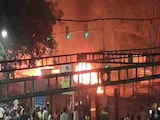- Rogue planet Cha 1107-7626 is 5-10 times larger than Jupiter and free-floating
- The planet consumes gas at six billion tonnes per second, like young stars
- Cha 1107-7626 showed an eightfold growth burst between early and August 2025
In a groundbreaking discovery, astronomers have found that a rogue planet named Cha 1107-7626 was behaving remarkably like a star. This planet is estimated to be 5-10 times bigger than Jupiter and located about 620 light-years away in the constellation Chamaeleon. Yet it doesn't orbit a star, making it a free-floating planetary-mass object.
The planet is devouring gas from its surrounding disk at an astonishing rate of six billion tonnes per second, a behaviour typically seen in young stars.
Also Read | Hidden Asteroids Near Venus Pose Long-Term Threat to Earth, Study Reveals
"People may think of planets as quiet and stable worlds, but with this discovery we see that planetary-mass objects freely floating in space can be exciting places," Victor Almendros-Abad, an astronomer at the Astronomical Observatory of Palermo, National Institute for Astrophysics (INAF), Italy and lead author of the new study, said as quoted by phys.org.
Cha 1107-7626's behaviour blurs lines between planets and stars, and suggests that the formation processes might be more universal than previously thought. However, the scientists suspect strong magnetic fields are driving this growth, similar to those found in stars.
Also Read | Viral Trend Of Getting Tattoos On Teeth Sparks Debate On Dental Health In China
As per the study, published in The Astrophysical Journal Letters, observations have also shown that Cha 1107-7626 underwent a colossal growth burst, with rates increasing eightfold between early 2025 and August 2025.
The discovery was made with the X-shooter spectrograph on ESO's VLT, located in Chile's Atacama Desert. Meanwhile, the James Webb Space Telescope (JWST) spotted water vapour in the disk during the growth burst, which is a phenomenon previously documented around stars but not planets.
"The origin of rogue planets remains an open question: are they the lowest-mass objects formed like stars, or giant planets ejected from their birth systems?" co-author Aleks Scholz, an astronomer at the University of St Andrews, United Kingdom, asked as quoted in the report.















